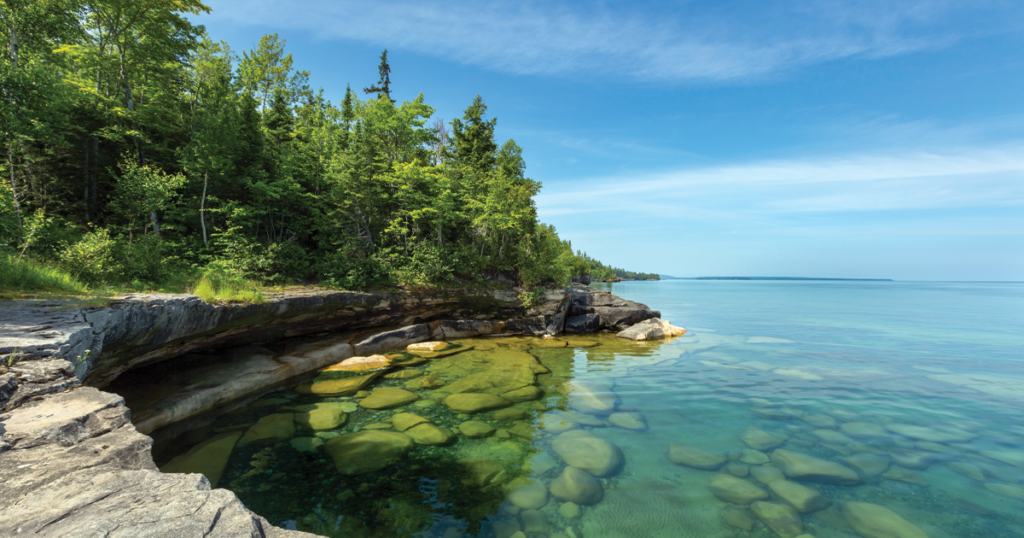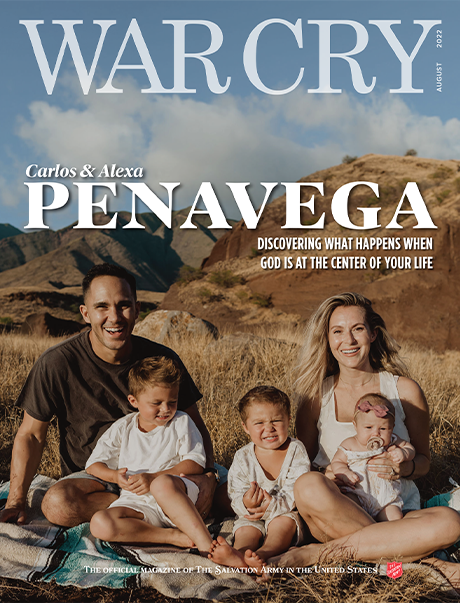What is Worship?
The beauty and experience of God’s creation during my 10-mile hike along Lake Superior certainly had all the ingredients of true worship.
My feet were getting tired, but my heart was joyful as I turned the corner and saw an opening in the trees. With the trees perfectly framing my view, I could clearly see the 200-foot drop down to the water. The water was the perfect aquamarine blue. The sandstone cliffs were a mosaic of browns and tans. The trees stood tall, seemingly enjoying the sunny day. I was standing on a cliff overlooking Lake Superior, halfway through a 10-mile hike. I couldn’t convince anyone else in my family to do such a long hike so I was by myself, but I never felt alone. With every turn in the path, every new vista, every wave that roared through the cavernous openings below me, I felt God’s presence. I felt my smallness in His vast creation, but I also felt His nearness to me personally. Was this worship?
What is worship really? Are there necessary ingredients required before it can be called worship rather than adoration, praise or prayer? Often, we refer to worship as a part of a Sunday morning service that includes singing. Worship certainly includes singing, but I think we can all agree there has to be more to it than that. Is worship defined by external factors such as location, activity or fellow participants? Or is it internal factors such as your heart, your sin and your disposition toward God?
The people of God in scripture were first taught how to worship through the Tabernacle. God chose to reveal Himself to His people (the Israelites) through Moses. He revealed how He wanted them to live through the Ten Commandments and He revealed how He wanted them to worship through the instructions of the Tabernacle. These instructions are found in Exodus 25-27. God showed Moses a pattern for the Tabernacle and instructed him to follow it closely (Exodus 25:8). It’s almost as if God revealed a vision of this Tabernacle that Moses was to copy on Earth. Hebrews 8:1-5 teaches us that there is in fact a heavenly Tabernacle, the true Tabernacle, which is far superior to what Moses was able to build. If the Tabernacle is both in our spiritual past and our heavenly future, it must still be relevant for God’s people to learn and understand today. I would propose that the Tabernacle teaches us what true worship is.
The Courtyard
If I were an Israelite wandering with Moses through the desert and wanting to worship in the Tabernacle, the first thing I would notice is the curtain. The curtain separated the courtyard from the rest of the camp. It was a rectangle 180 feet long and 90 feet wide. The curtain was constructed of fine, white linen and stood 7.5 feet tall, taller than any person to easily see over. On one end there was a large entrance, but it was also made of a curtain, so there was no place one could easily see in (though being a curtain, it would have been easy to hear all the commotion inside!). Throughout scripture, white linen symbolizes purity, holiness and righteousness. The curtain is a physical reminder that God is holy. Entering His holiness requires the worshiper to also be holy. An Israelite could not accidentally wander into the place of worship; he had to intentionally enter. There was a clear division. Though God loves all people and desires all of them to enter His presence, it takes some awareness of who He is in order to enter. Worship spaces today do not need a curtain to divide the inside and outside, but to truly worship, we do need to recognize who He is and who we are. We are invited to enter His presence just as we are, with our sin, our past, our burdens. In His presence, we are invited to give these things over to Him.
The Entrance
In order to enter the Tabernacle, one would go through the 30-foot-long entrance covered with a blue, purple and scarlet curtain. Blue, the color of the sky, likely represents God. Purple is the color of royalty, symbolizing a king. Scarlet is the color of blood and sacrifice. All these colors together point to Jesus Christ, who is God, King and the ultimate sacrifice. Jesus Himself makes clear that He is the entrance to the Kingdom of God in John 10:9 when He says, “Yes, I am the gate. Those who come in through me will be saved.”
The Altar
Upon entering the Tabernacle, one would notice that the only things in the large courtyard were an altar, a water basin and a large tent. The altar was 4.5 feet high and 7.5 feet long and wide. There, animals were sacrificed daily according to the instructions given by God in other portions of Exodus and Leviticus. Animal sacrifice goes all the way back to the Garden of Eden and the first sin. When Adam and Eve ate the fruit from the tree, they realized their nakedness and hid from God (Genesis 3:10). Then God Himself, in His mercy, made garments of skin to clothe Adam and Eve. Animals would have been killed to make these garments. This clearly illustrates what Romans 6:23 tells us, “For the wages of sin is death…” The sacrifice of animals was an opportunity for the Israelites to demonstrate visibly that they knew they were sinners, and now brought a costly offering to cover the price of their sins. Of course, an animal can never cover sins forever. Thankfully, Jesus offered Himself as the perfect sacrifice and we no longer need to offer animal sacrifices. Instead, we can offer our lives to Him. Our recognition of Jesus’ sacrifice makes reconciliation between us and God possible. Sin no longer needs to separate us.
The Basin of Water
Between this altar and the large tent was a basin filled with water. This was for the priests to wash their hands and feet before entering the tent of meeting (Exodus 30:19). Throughout scripture, water is an agent of washing, both physically and spiritually. While the altar represents a place of reconciliation between God and man (a one-time event), the basin of water represents God’s invitation to sanctification (an ongoing process). Reconciliation is just the beginning of a relationship with a loving, heavenly Father. Sanctification is the maturing of that relationship as communication, obedience and love grow in the believer.
Our Invitation
The outer court was a place of preparation for the people as they got ready to meet with God. In the Old Testament, only Levites could progress on to enter the Holy Place and eventually, the Holy of Holies. Jesus’ death has torn that veil and now we all have an open invitation to approach Him. But the lesson of the Tabernacle is that it should not be done lightly. There is a preparation process that God Himself has provided for us to meet with Him. That process begins with an awareness of His holiness, continues with a realization of our own sin, and grows as we continually respond to His direction and trust Him daily with our lives.
The beauty and experience of God’s creation during my 10-mile hike along Lake Superior certainly had all the ingredients of true worship. I had a recognition of who He was, I had an awareness of who I was in relation to Him, and I spent those hours alone in continual communion with Him. Hopefully our communal worship on Sunday mornings will also include these aspects, as they are so clearly taught from the Tabernacle. We will continue to explore more aspects of worship next month as we look at the Holy Place.
Questions to consider:
- Have you had an experience of worship that changed you? How did it make you feel?
- Is there any sin in your life that you need to bring to the altar and leave there?
- How can you participate in communal worship in order to help yourself and others encounter the presence of God?
PHOTO BY iStock / Getty Images Plus







